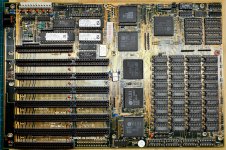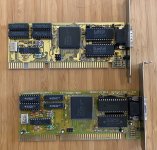Paul-VT
Member
Hello Everyone,
I recently purchased a 286 clone from eBay. The steel horizontal case ans PSU are in great shape and for $100 I thought it would be a good start to a fun retro project. To my delight, the motherboard inside looked to be in good shape also. With a bit of vinegar, alcohol and elbow grease, I removed the slightly leaky battery and cleaned the motherboard.
It also came with a working MFM/Floppy controller and working ST-225 which tested good in my IBM 5150.
The motherboard is a 286-12Mhz clone with the VLSI 82C100 chipset and 1MB RAM. I have found similar boards online but no exact match.
The board boots fine but there are some issues during use:
1. With a known good vga card (Trident 9000) on the bus, the board always boots but half the time the vga card's bios message which should be in color text shows in white text only and no colors are possible in any programs/games. The other half of the time it boots properly and color vga games work fine. No difference between cold boot and warm boot with reset switch or ctrl-alt-del. This is the main concern as it happens with no other cards on the bus.
2. The UMC IDE controller seems flaky, especially with a IDE to CF adapter. I have tried different CHS values in the bios and different CF cards but I consistently get random write errors ("General failure error writing to drive C"). Especially when installing DOS 6.22 from floppy. This controller/CF adapter combo tested good in my 486.
3. The 3-Com, parallel tasking, 3c509 works but using ftp to get files from my server causes lockups and I have to reboot. This networking card tested good in my 486.
I have tried different CPUs (12 and 16 MHz), and RAM. The board is not overclocked. I have de-soldered the keyboard connector and cleaned underneath. I have checked for broken traces with my meter. I have removed and re-seated all socketed chips. I have tried different power supplies. No luck.
Unfortunately, my 3 year old Siglent 'scope now refuses to boot (tried the 'math' button trick already but no) so I can't use it to check for clock or voltage instability right now.
Could it be a bad BIOS or flaky old BIOS chips? A sneaky bad old tantalum capacitor? Unstable clocks and voltages?
Any thoughts would be much appreciated.
Thank you.
-Paul in Vermont

I recently purchased a 286 clone from eBay. The steel horizontal case ans PSU are in great shape and for $100 I thought it would be a good start to a fun retro project. To my delight, the motherboard inside looked to be in good shape also. With a bit of vinegar, alcohol and elbow grease, I removed the slightly leaky battery and cleaned the motherboard.
It also came with a working MFM/Floppy controller and working ST-225 which tested good in my IBM 5150.
The motherboard is a 286-12Mhz clone with the VLSI 82C100 chipset and 1MB RAM. I have found similar boards online but no exact match.
The board boots fine but there are some issues during use:
1. With a known good vga card (Trident 9000) on the bus, the board always boots but half the time the vga card's bios message which should be in color text shows in white text only and no colors are possible in any programs/games. The other half of the time it boots properly and color vga games work fine. No difference between cold boot and warm boot with reset switch or ctrl-alt-del. This is the main concern as it happens with no other cards on the bus.
2. The UMC IDE controller seems flaky, especially with a IDE to CF adapter. I have tried different CHS values in the bios and different CF cards but I consistently get random write errors ("General failure error writing to drive C"). Especially when installing DOS 6.22 from floppy. This controller/CF adapter combo tested good in my 486.
3. The 3-Com, parallel tasking, 3c509 works but using ftp to get files from my server causes lockups and I have to reboot. This networking card tested good in my 486.
I have tried different CPUs (12 and 16 MHz), and RAM. The board is not overclocked. I have de-soldered the keyboard connector and cleaned underneath. I have checked for broken traces with my meter. I have removed and re-seated all socketed chips. I have tried different power supplies. No luck.
Unfortunately, my 3 year old Siglent 'scope now refuses to boot (tried the 'math' button trick already but no) so I can't use it to check for clock or voltage instability right now.
Could it be a bad BIOS or flaky old BIOS chips? A sneaky bad old tantalum capacitor? Unstable clocks and voltages?
Any thoughts would be much appreciated.
Thank you.
-Paul in Vermont


